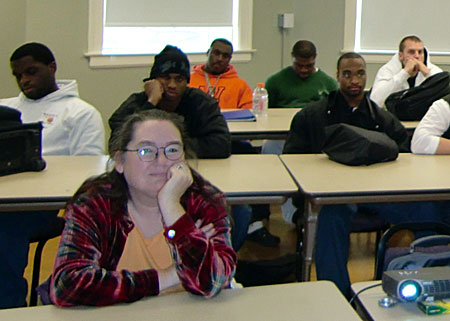Professor Kristin Cherry teaches a beginning Radio course at Central Methodist University in Fayette, MO, and was kind enough to invite me come talk about… radio. I didn’t know what to say about “radio” so I made a list (“10 Survival Tools for the Digital Age”) of things I was pretty sure they already knew about. They didn’t. [Just click a slide to see the next one] The photo below was taken just as my presentation peaked.

I don’t have the opportunity to spend a lot of time around young people but I’ve come to believe they are no more web savvy than the population at large. They’re great at texting and know the ends and outs of Facebook… but very few are creating media or exploring.
In my group of about 25 students, only one had uploaded a video to YouTube and that was for a class assignment. Twitter, UStream, flickr? Never heard of them.
I tried to convey the idea that these –and similar tools– will be useful no matter what they do after college. What I forgot (it was a very long time ago) was that they had very little interest in next semester, let alone The Rest of Their Lives.
The instructors (and the administration!) were incredibly gracious hosts and the campus is really pretty. As always, I got much more out of this experience than the students. More on that in a future post. [Wikipedia entry for “film strip”]

 “I’ll need a better setup than just hanging the web cam from a couple of lanyards and a bag…when it got windy, or when there was a foul ball, the camera shook and I had to reposition it numerous times. Likely a tripod or perhaps a platform that is more securely attached to the fence and would allow for a higher angle is what I’m going to experiment with next.”
“I’ll need a better setup than just hanging the web cam from a couple of lanyards and a bag…when it got windy, or when there was a foul ball, the camera shook and I had to reposition it numerous times. Likely a tripod or perhaps a platform that is more securely attached to the fence and would allow for a higher angle is what I’m going to experiment with next.” Regular readers know smays.com is all about getting those photos and home movies out of the closet and up on flickr and YouTube. I’ve even posted a time or two about
Regular readers know smays.com is all about getting those photos and home movies out of the closet and up on flickr and YouTube. I’ve even posted a time or two about